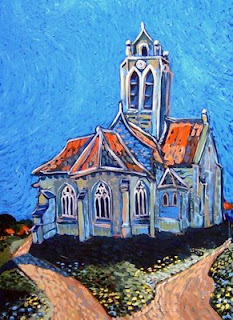
Above: Ray's copy of Van Gogh's "Church at Auvers".
WHAT TO KEEP IN AND WHAT TO LEAVE OUT
Artists have a tendency to add order to what they see - this usually means leaving out superfluous detail when composing their picture – and ‘tweaking’ the things they find interesting or important to give them more importance in the composition.
Before you start, you will probably have some idea of what you want to achieve. (If not, look at other artists’ paintings in art books for inspiration or look at photographs or the things around you that capture your interest).
You may decide that you want to create a landscape or a flower study or a portrait or something abstract.
But always remember that you are not creating reality - rather you are creating an illusion of reality. This means that too much detail may have a tendency to clutter your painting or drawing and you must train yourself to leave unnecessary details out of your picture.
Start off by looking carefully at the subject. Then do your best to transpose what you see as accurately as you can onto your working surface. However, you may not necessarily need to capture every detail of every petal or leaf in a flower study for example. Exact details of a fabric pattern on the subject’s shirt - or every facial line - may not be required in your portrait. It would be impossible to capture the details of each roof tile in a painting of a village or building.
So look for the essentials, and leave out unnecessary detail. Eventually you will develop your own formula or convention to represent these features.
This does not mean that there’s no need to look very carefully at what you are painting or drawing. Accuracy is vital and this step will govern all subsequent stages as well as the final result.
At a later point in your development you may wish to distort the shapes or colours, but in the beginning you should try to capture your subject as accurately as possible.
(In my copy of Van Gogh's church, I've left out the figures in the foreground because I was more interested in the building, the colours and the post-impressionist style. But in the original, it is obvious that Van Gogh was not that interested in the building per se. He wanted to catch the emotion of the day, the amazingly intense and emotional colours - and he was quite happy to forsake architectural detail to achieve this).


No comments:
Post a Comment